Self Control Games for Kids: Building Essential Life Skills Through Play
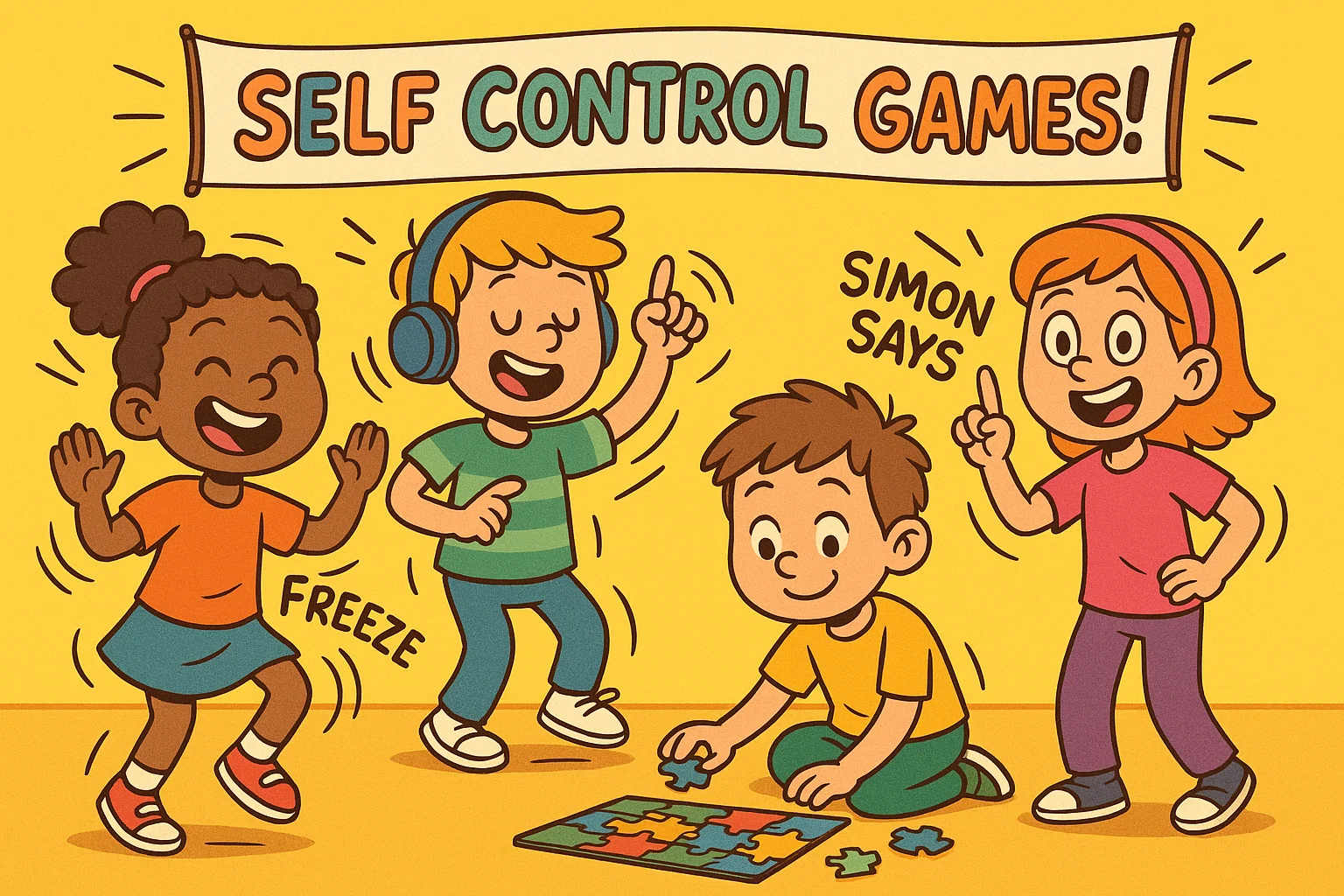
Managing sudden outbursts, impatience, or lack of focus is a normal part of raising children, but these moments highlight the importance of developing self-control. Strong self-regulation is a key executive function that supports learning, relationships, and long-term success. The good news: kids don’t need lectures to build these skills—playful, structured games are one of the most effective ways to practice emotional regulation, impulse control, and focus. This guide explores fun, practical activities parents and educators can use to help children strengthen self-control through play.
Importance of Self Control in Child Development
Self-control in children, often used interchangeably with self-regulation, is the ability to manage one’s emotions, thoughts, and behavior effectively in different situations. It involves resisting immediate temptations or impulses and remaining focused on long-term goals. Far from being a mere matter of obedience, strong self-control is a powerful predictor of future success.
The Dunedin Multidisciplinary Health and Development Study, which tracked over 1,000 children in New Zealand for four decades, found that childhood self-control strongly predicted adult outcomes in health, financial stability, and even criminal behavior—independent of intelligence and family background. These findings highlight the lifelong importance of fostering self-control early in childhood, as confirmed by the Dunedin Study.
Role of Self-Control in Emotional Regulation
Emotional regulation skills are a key component of self-control. It’s the ability to respond to strong feelings in a manageable, socially acceptable way.
When a child is upset about losing a game, their brain’s lower, emotional centers can take over. Self-regulation skills allow them to pause, apply a strategy like deep breathing or taking a brief break, and choose a more constructive response than hitting or yelling. This ability to manage their emotions enables them to navigate conflict, disappointment, and frustration more effectively.
Impact on School Performance and Behavior
In the classroom, self-control is crucial for academic success. Children learn self-regulation to:
- Focus and pay attention to the teacher despite distractions.
- Control their impulses to speak out of turn or disrupt others.
- Persist on difficult tasks, even when frustrated.
- Follow multi-step directions and manage time (like completing an assignment).
This combination of attentional focus and impulse control directly correlates with better school readiness and improved grades. As educator Bill Crawford, PhD, observes,
“Until we teach our kids to self-regulate, we will be stuck trying to reason with their unreasonable brain, which will only leave everyone stuck in the cycle of conflict.”
Benefits for Social Interactions and Friendships
Social skills are fundamentally reliant on self-control. Successful friendships and play require children to:
- Wait their turn during a conversation or a fun game.
- Tolerate frustration and disappointment (like not getting their way).
- Practice self-control by sharing toys and resources.
- See another person’s perspective (a core component of empathy).
Games that emphasize cooperation and turn-taking are a powerful way to practice social emotional skills and help children learn to manage their emotions in a group setting.
Self Control Games with Movement
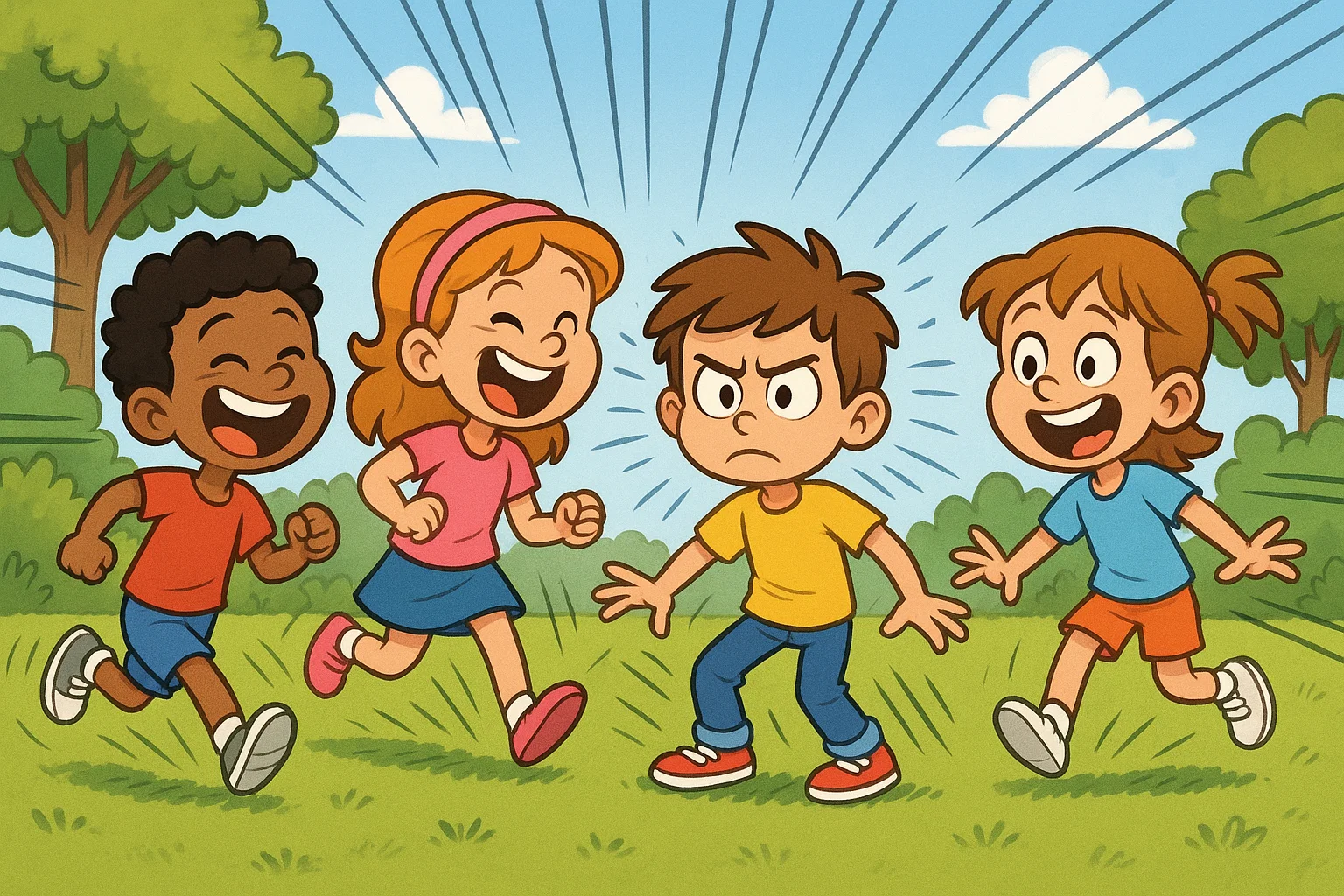
Movement-based games are fantastic for teaching kids to regulate their bodies and minds simultaneously. They help children practice body control, especially the all-important skill of inhibitory control—stopping a planned action when a cue is given. These physical activities are highly engaging and require no specialized equipment, making them easy to implement indoors or outdoors.
| Game | Skill Targeted | Description |
| Red Light Green Light | Impulse Control, Listening | The child must stop and start movement instantly based on a verbal cue. |
| Simon Says | Auditory Attention, Focus, Impulse Control | The child must only follow instructions that start with the phrase “Simon Says.” |
| Freeze Dance | Body Regulation, Listening | Kids dance to music and must “freeze” instantly when the music stops. |
Red Light Green Light
This classic game is a great way to practice following rules and inhibiting impulses.
- How to Play: One person is the “caller.” When the caller shouts “Green Light,” the players move. When the caller shouts “Red Light,” everyone must freeze instantly.
- Advanced Variation: Introduce “Yellow Light,” meaning players must move slowly. This adds a layer of cognitive flexibility and helps children to control their speed.
Simon Says (Focus on Listening and Impulse Control)
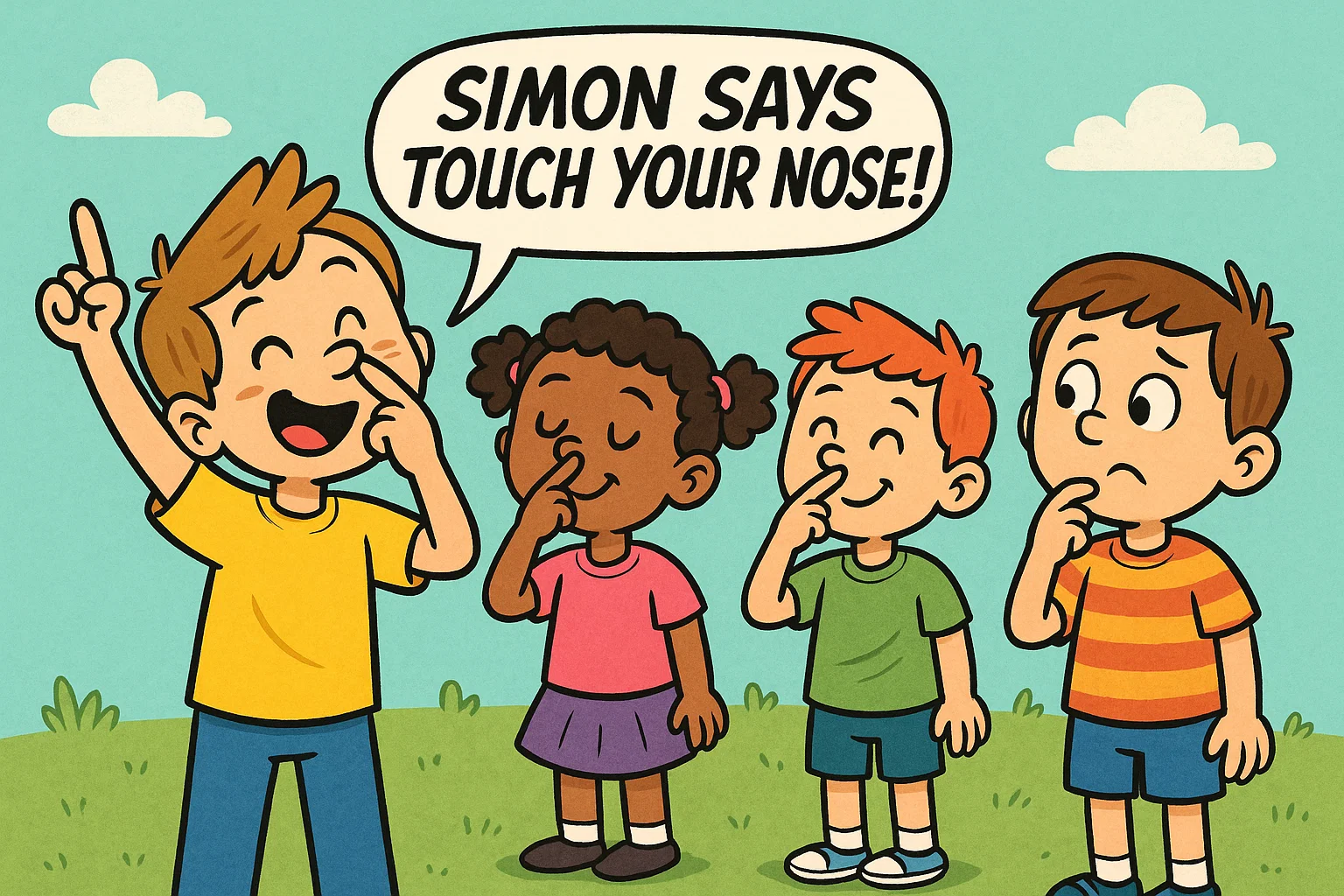
Simon Says is one of the best games to teach self-control by forcing children to use their listening skills before reacting.
- How to Play: The caller instructs players to perform an action, but players should only move if the command is preceded by the phrase “Simon Says.” If a player moves without the “Simon Says” cue, they are out (or simply tagged and join the caller for a softer approach).
- Benefit: This requires children to pause for a microsecond to assess the instruction—a critical step in developing self-regulation skills.
Freeze Dance (Combine Music, Fun, and Regulation)
Freeze Dance is a fun activity that works brilliantly for a wide age range.
- How to Play: Put on music and tell kids to dance. When the music stops, they must freeze in their current position. Any movement gets them out (or a silly penalty, like doing a silly walk).
- Tip: Encourage kids to try standing on one foot or striking funny poses to make the freeze more challenging and engaging.
Balloon Tap or Keep It Up (Cooperative Play for Patience)
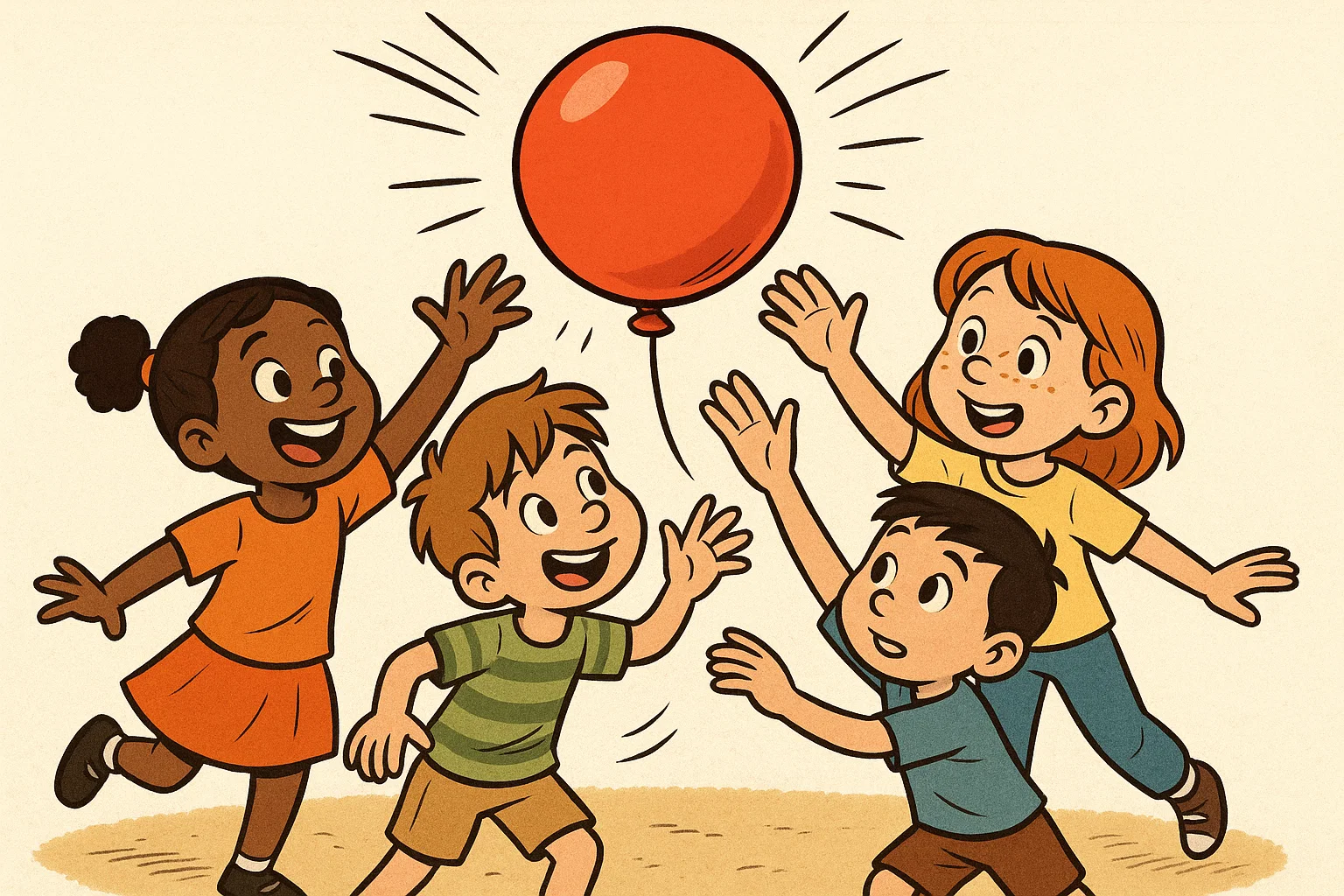
This cooperative activity requires gentle movements, which contrasts with the stopping and starting of the other games.
- How to Play: The goal is to keep a lightweight balloon (or a beach ball) from touching the ground using gentle taps. The challenge is that a player can only tap the balloon once before another player must take a turn.
- Benefit: It promotes patience, cooperation, and fine motor skills by requiring soft, measured strikes instead of hard hits—a quiet, gentle way to practice self-control.
Self Control Games Developing Focus and Attention
These activities train concentration, patience, and mindful waiting, helping children to focus for longer periods. They are excellent resources to help develop self-control skills that translate directly to academic tasks.
Jenga (Planning and Careful Moves)
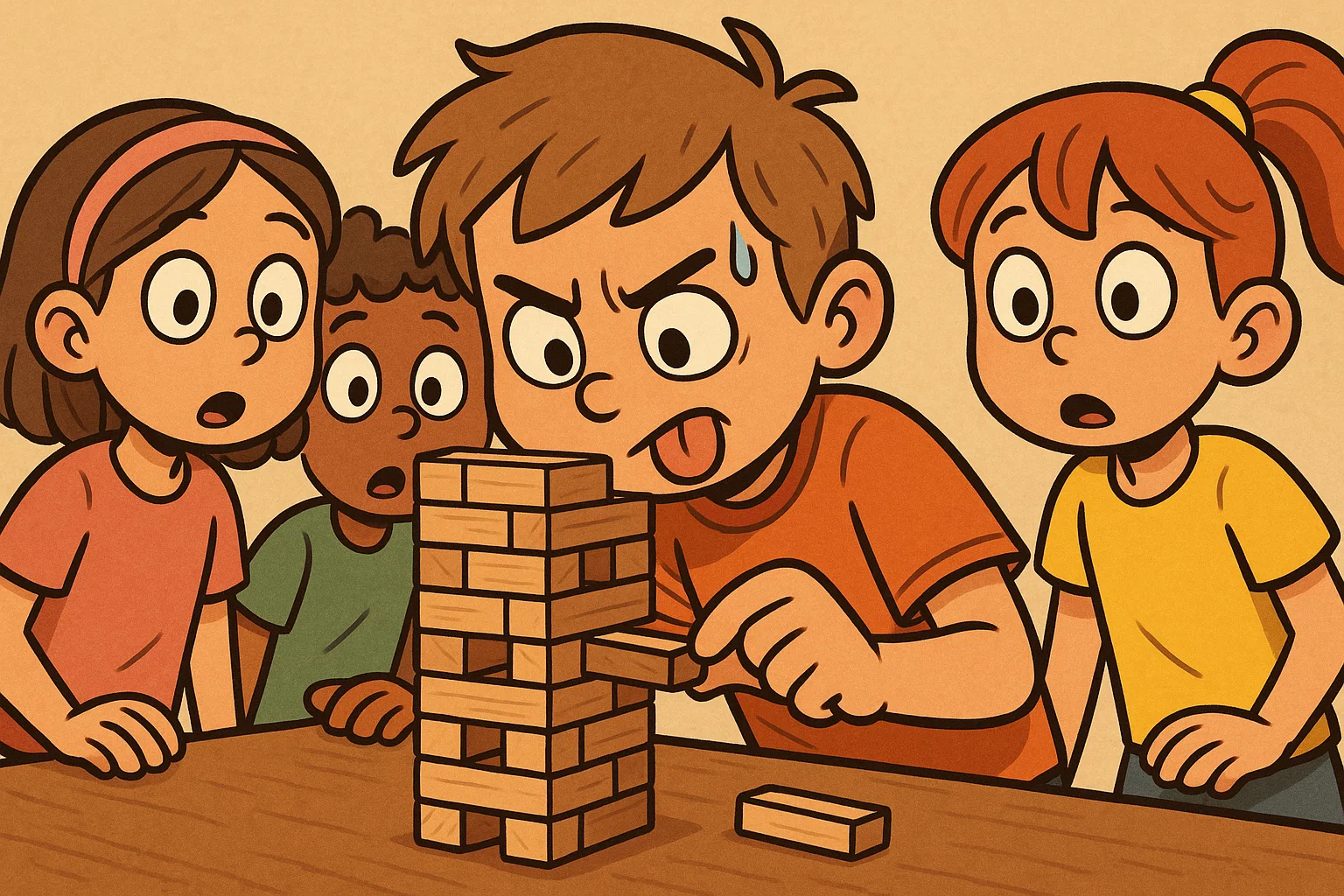
Jenga is a great game that requires slow, careful, and deliberate action.
- How to Play: Players take turns removing a single block from a tower and placing it on top, without causing the tower to fall.
- Benefit: The suspense of not wanting to be the one to knock over the tower naturally encourages planning, careful movements, and impulse control. The required focus is intense, making it a powerful regulation activity.
Pencil Balancing Game (Fine Motor and Focus Challenge)
A simple activity that enhances concentration and fine motor skills.
- How to Play: Challenge children to stand a pencil upright on a table or their finger for as long as possible. For an easier version, have them balance a small toy or marble on a spoon and walk across the room.
- Benefit: Requires stillness, focus, and precise, controlled movements, teaching kids to regulate their body for a sustained period.
Timed Puzzles (Delayed Gratification Practice)
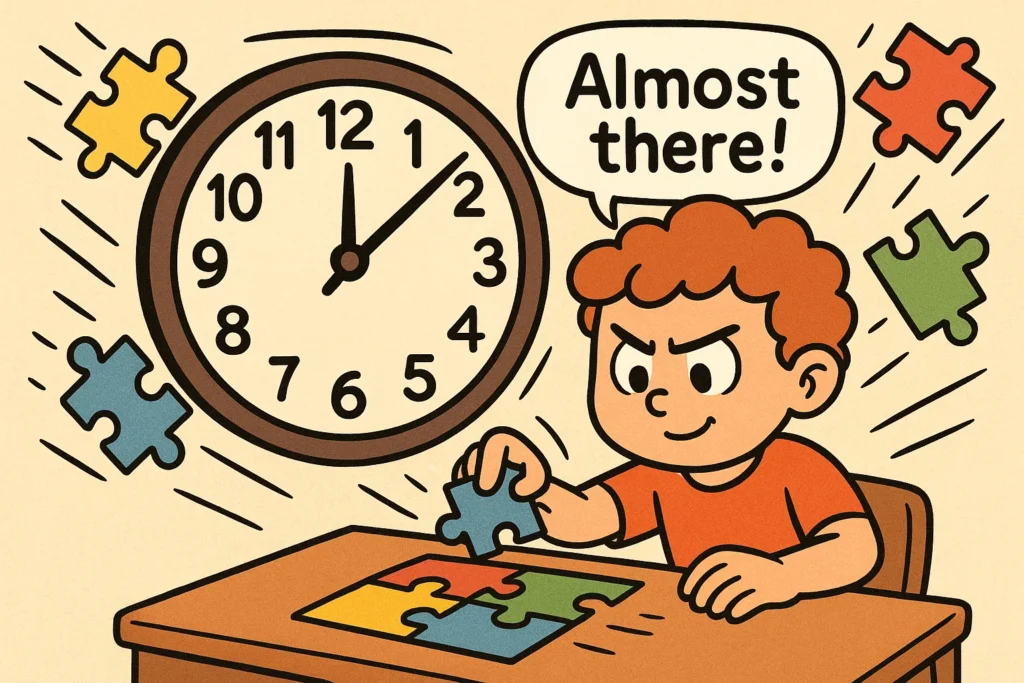
Turning a traditional activity into a race against the clock can introduce delayed gratification.
- How to Play: Have children work on a puzzle, but set a timer for a short, achievable goal (e.g., “Let’s put together the border pieces before the timer goes off!”). Or, offer a small reward after they finish the puzzle completely.
- Benefit: Teaches them to tolerate the challenge of a task (persistence) and that waiting until the job is complete leads to a satisfying conclusion, a classic way to practice self-regulation.
Clap Pattern or Copycat Games (Attention and Memory)
A superb activity to help children focus on auditory and visual cues.
- How to Play: One person creates a rhythmic clap pattern, and the other must listen and repeat it exactly. Increase the complexity of the patterns over time. Alternatively, the Mirror Game is a fun game where one child is the leader and the other is the ‘mirror,’ copying every movement and facial expression precisely, requiring intense attention to the leader’s actions.
- Benefit: Requires keen attention, working memory, and the self-control to suppress their own desired movements to accurately copy the leader.
Self Control Games in Daily Life
Teaching skills like self-regulation works best when woven into the fabric of everyday routines. These activities and games show parents ways to help children learn self-regulation without needing to dedicate “game time.”
During Meals (Waiting Turns, Mindful Eating)
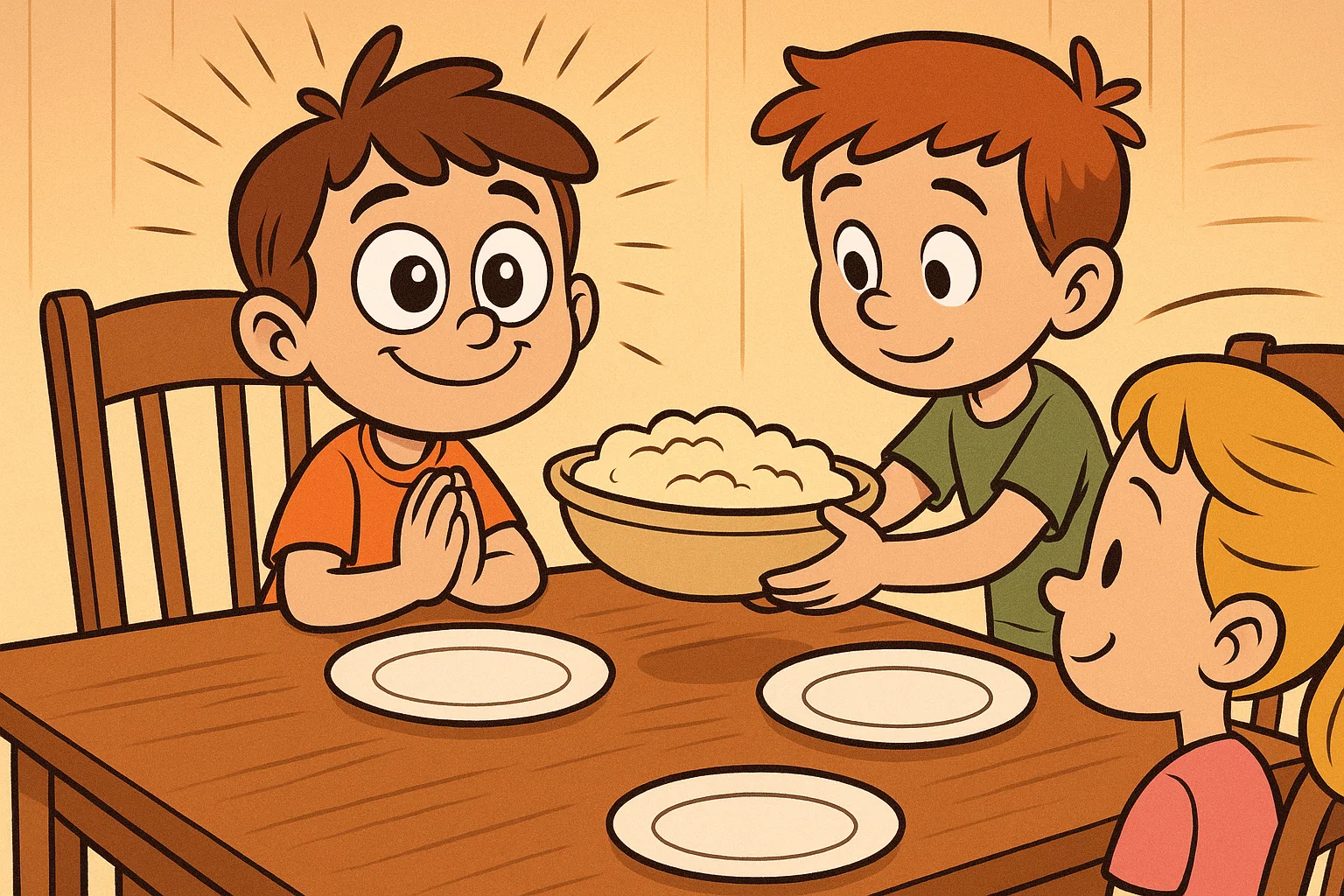
- Waiting Turns: Instead of rushing to get a request met, encourage children to wait for a natural break in the conversation before asking for more food or a drink.
- Mindful Eating: Play a fun game where everyone takes a small bite of food and holds it on their tongue for five seconds before chewing. This slows down the pace and helps children to control their impulses to rush.
Before Bed (Calm-Down Rituals, Quiet Waiting)
- Deep Breathing/Mindful Breathing: Introduce a “calm-down” kit or a simple ritual like “Starfish Breathing” (spread fingers wide like a starfish, trace each one slowly while inhaling and exhaling). This is a vital strategy for developing emotional regulation skills.
- Quiet Waiting: Challenge them to lie in bed quietly for two minutes before starting the bedtime story. Use a gentle timer to manage expectations.
In the Store (Patience While Shopping)
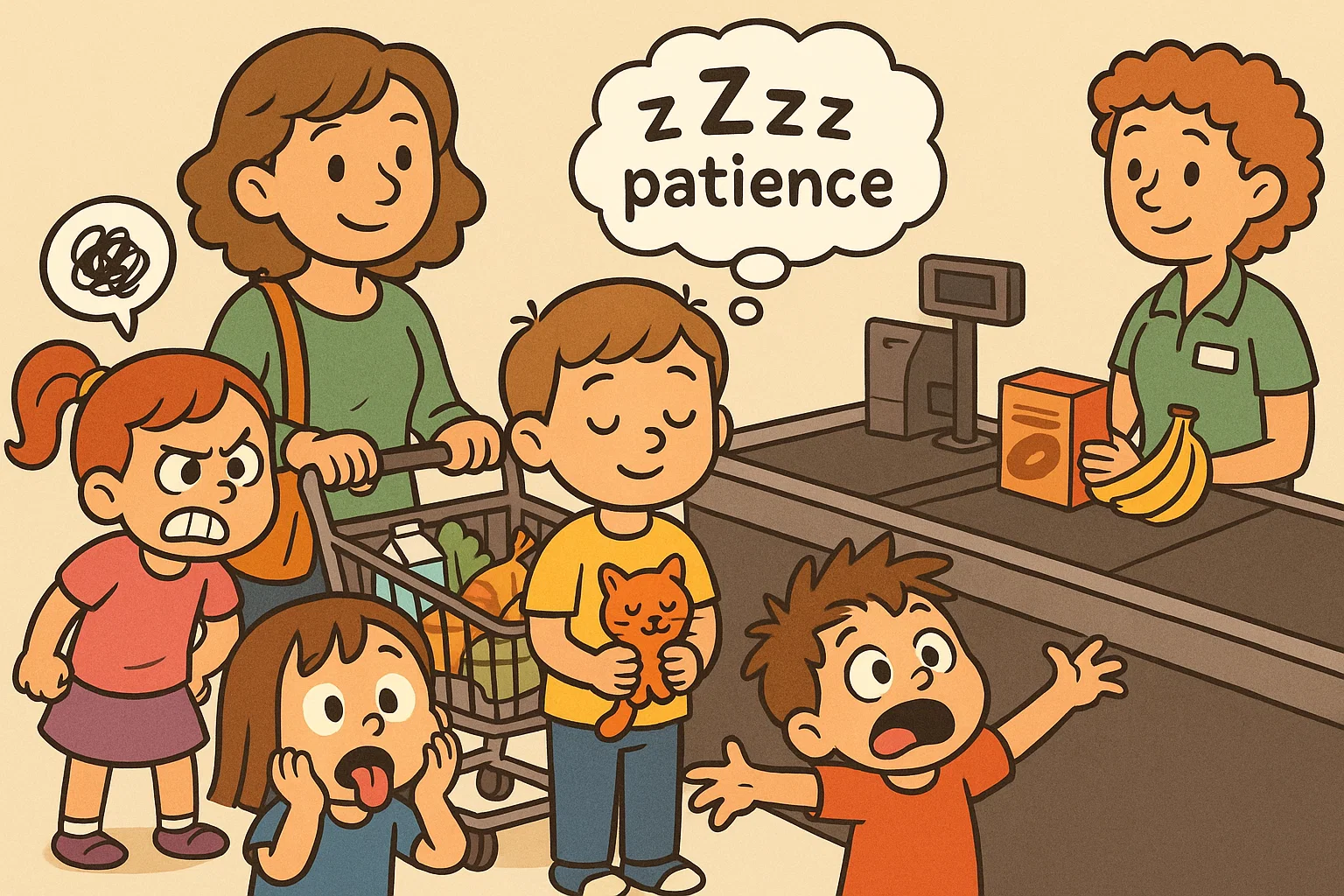
- I Spy for Focus: Playing “I Spy” or a similar observation game helps children to focus their attention outward instead of dwelling on desires for toys or snacks.
- Helper Game: Give your child a specific, tangible job, like carrying the list or finding three cans of green beans. Giving them a sense of control over a task helps them learn self-regulation in a different situation.
On Walks or in the Car (Games that Train Waiting)
- Green Light, Red Light (Verbal): In the car, say “Green Light” to talk and “Red Light” to be quiet. This is a verbal twist on the classic game, teaching children to control their impulses to chatter continuously.
- The Quiet Game: See who can be silent for the longest stretch of time (make sure it’s short and fun, not punitive!).
Creative and Social Self Control Games
These activities blend the practice of impulse control with the social emotional skills needed for cooperation and imagination.
Back-to-Back Drawing (Communication and Patience)
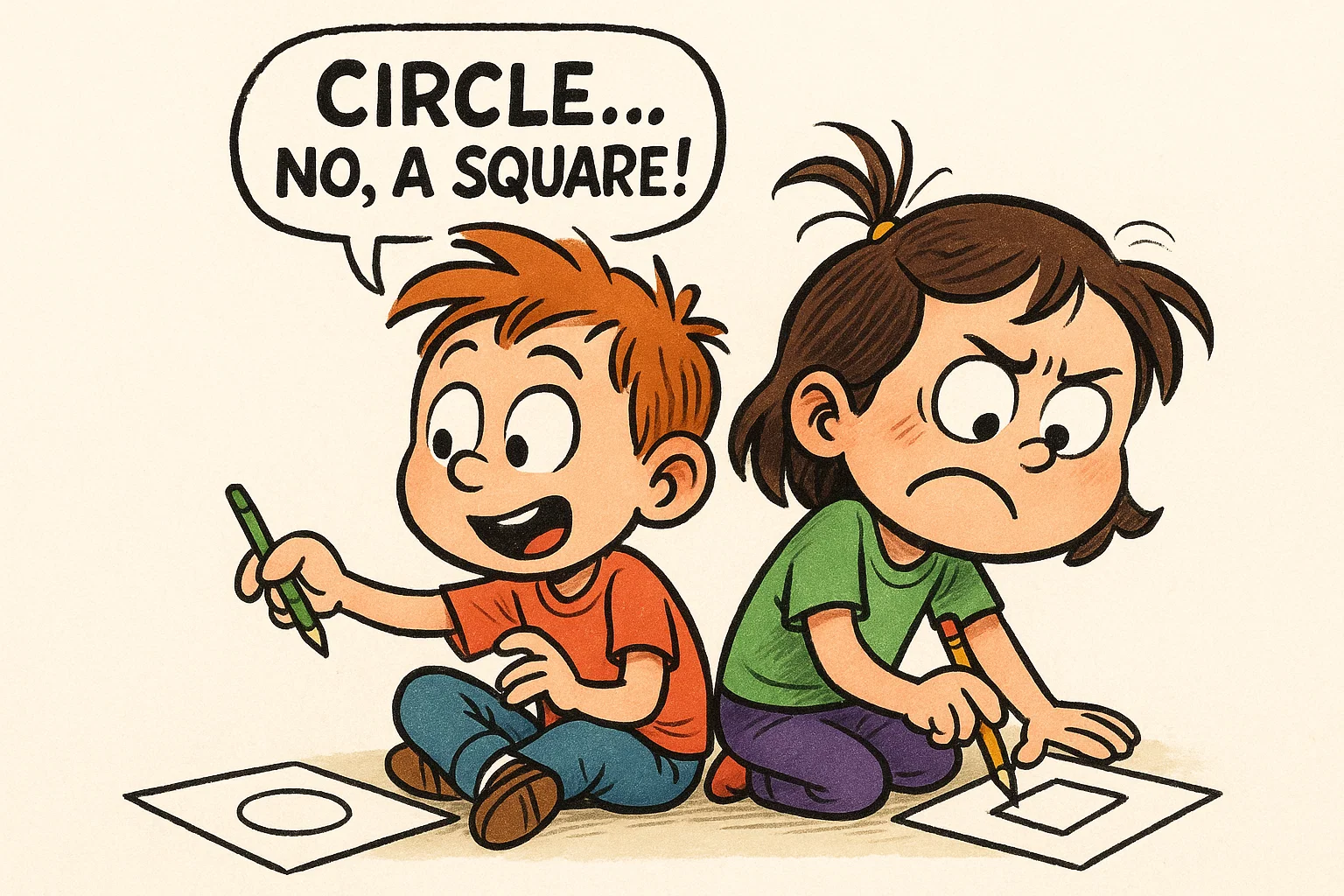
- How to Play: Two children sit back-to-back. One child describes a simple drawing (e.g., a square with a triangle on top) without naming the shapes. The other child tries to recreate the drawing based on the verbal instructions.
- Benefit: This activity is good for teaching focused listening, clear communication, and incredible patience, as the describer must pause and wait for the listener to draw.
I’m Going on a Picnic (Memory and Turn-Taking)
- How to Play: The first player says, “I’m going on a picnic and I’m bringing…” an item starting with ‘A’. The next player repeats the phrase, lists the ‘A’ item, and adds an item starting with ‘B’, and so on.
- Benefit: A great game to practice memory, patience, and waiting respectfully for their turn. It also requires the self-control to not interrupt the chain.
Don’t Break the Ice (Anticipation and Impulse Control)
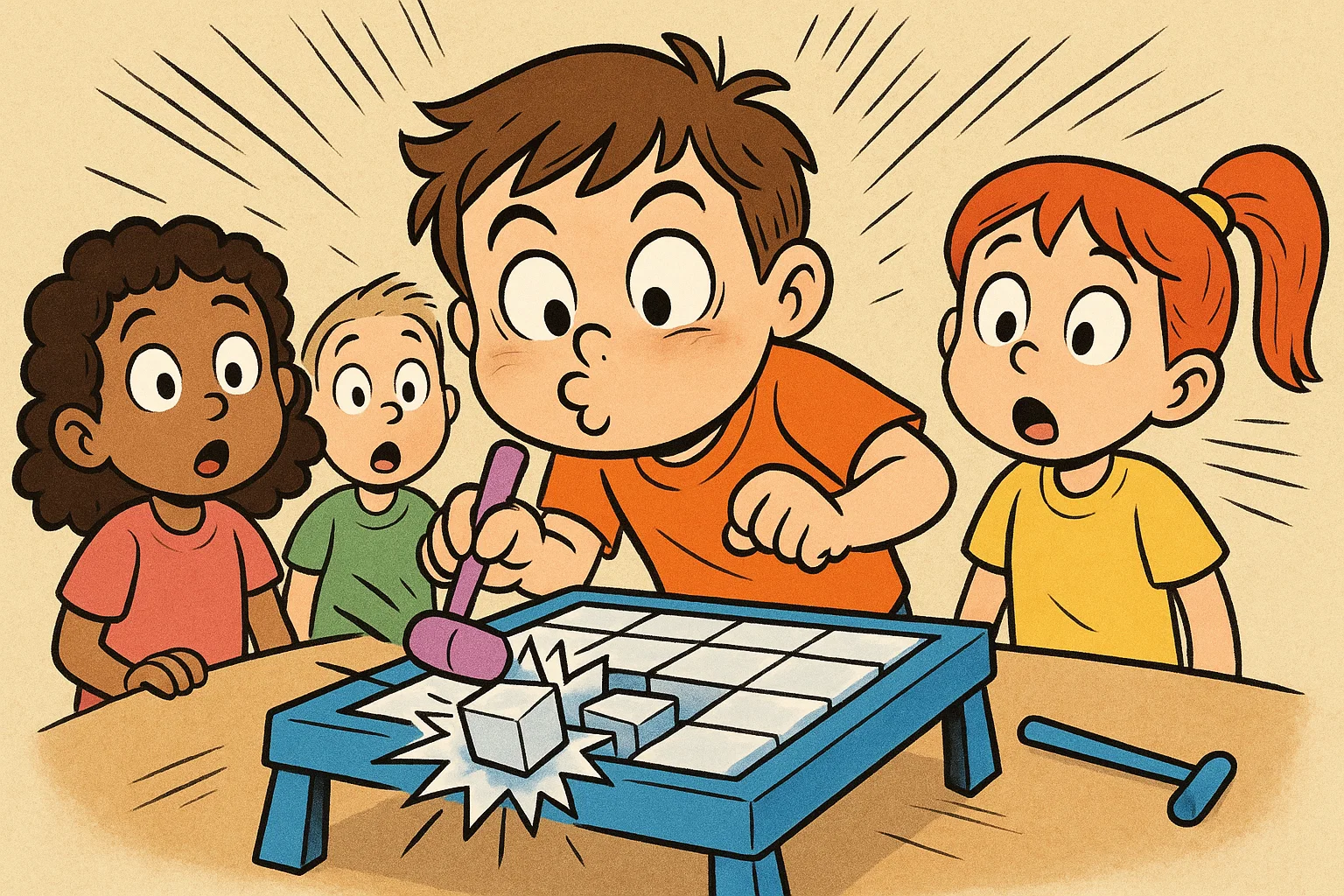
- How to Play: A popular children’s fun game where players take turns tapping out plastic ice blocks without knocking the figure off the platform.
- Benefit: This game helps children practice delayed responses and careful physical control. The anticipation builds, requiring children to control their impulses for a quick, hard hit.
Mirror Game or Statue (Self-Regulation Through Mimicry)
- How to Play: In the Mirror Game, two kids face each other; one is the leader and the other is the mirror, mimicking movements slowly and precisely. In the Statue game, children move to music and must freeze perfectly still in a statue pose when the music stops, a powerful way to practice body control.
- Benefit: These games require intense focus on external cues and the ability to hold a position, building core self-regulation skills.
Games for Kids with ADHD
Children with ADHD often face amplified challenges with focus, emotional regulation, and impulse control. The development of self-regulation can be supported with modified, short, and highly structured activities that offer frequent feedback and positive reinforcement. These self control activities for kids work best when tailored to the child’s specific needs.
| Game Adaptation | Skill Focus | ADHD Strategy Used |
| Quiet Hunter | Controlled Movement, Focus | Incorporates movement into a structured, quiet task. |
| Bubbles Game (Delayed Pop) | Impulse Training, Waiting | Uses an irresistible impulse (popping) to practice restraint. |
| Build by Sample (LEGO/Block) | Visual Attention, Patience | Breaks down complex planning into manageable steps. |
| Short, Structured Activities | Sustained Effort, Focus | Shorter duration aligns with lower attention span, uses rewards. |
Quiet Hunter (Controlled Movement)
- How to Play: Hide a few items around the room. The child must find them, but must move as quietly as possible, like a “quiet hunter.”
- Benefit: Provides a physical outlet while forcing the child to slow down and practice controlled movement and body awareness.
Bubbles Game (Delayed Popping for Impulse Training)
- How to Play: Blow bubbles, but the rule is that the child can only pop the bubbles after a certain cue (e.g., a clap, or only after the bubble floats past their head).
- Benefit: Uses a high-interest activity to build impulse control. The natural desire to pop the bubble is a strong impulse that must be overridden.
Build by Sample (Visual Attention and Patience)
- How to Play: Using a visual card or a small picture, challenge the child to build a specific block or Jenga structure. Start with a very small structure (e.g., three blocks) and increase complexity slowly.
- Benefit: Builds visual attention, sequencing, and the patience to complete a step-by-step goal.
Short, Structured Activities with Rewards
Keep activities brief—maybe 3 to 5 minutes—and provide immediate, high-value praise and a concrete reward (e.g., a sticker, a minute of extra screen time) for successful task completion. The structure and clear end goal are vital for managing attention.
Digital Tools Supporting Self Control
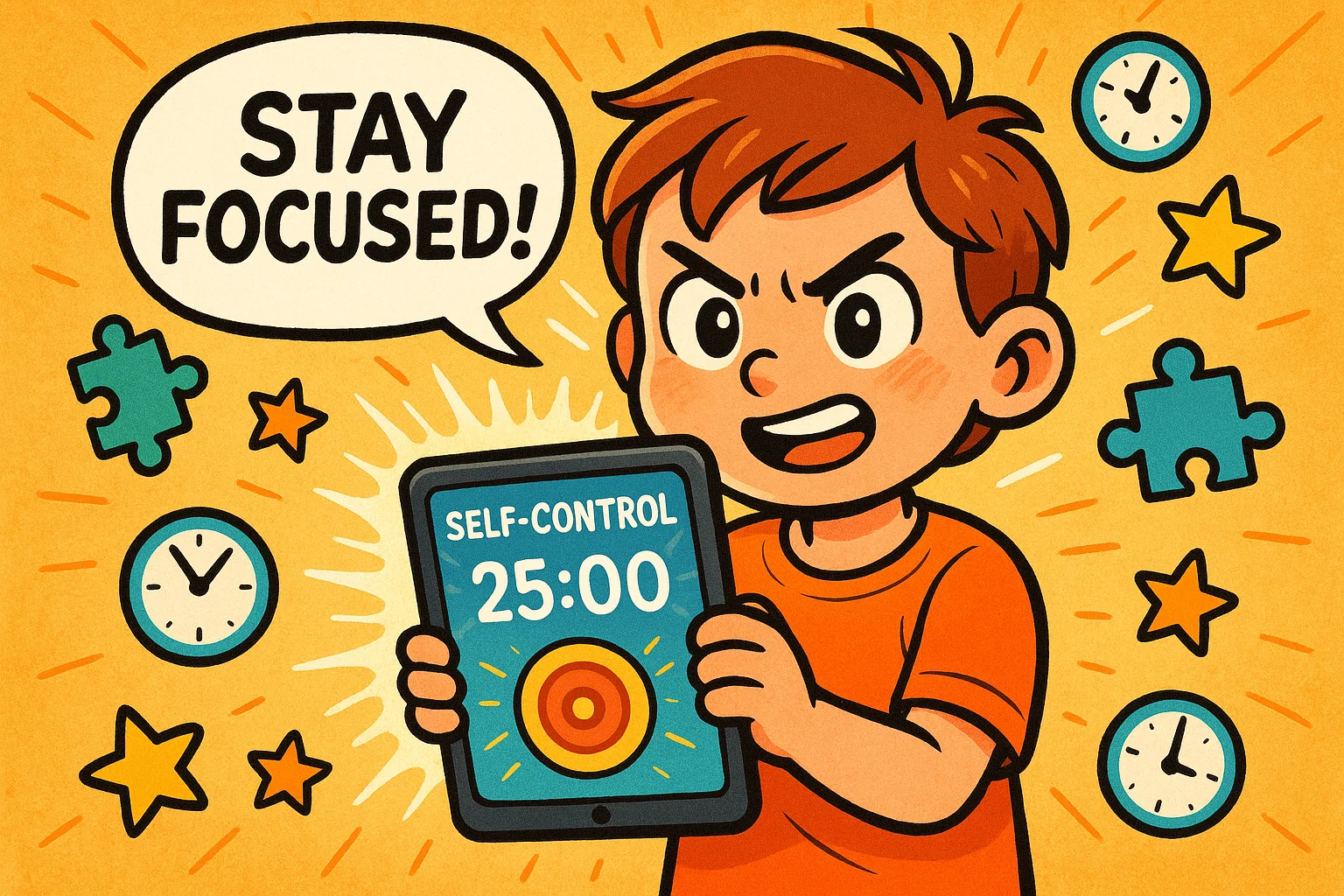
In today’s world, screen time can be an arena for practicing self-control. While real-life, social interaction-based games are crucial, certain digital tools can support the development of self-regulation skills.
Best Self-Regulation Apps for Kids
Many apps now integrate cognitive behavioral therapy (CBT) techniques, mindful breathing, and visual cues to help kids to regulate emotions. For example, apps focused on building a “calm-down corner” or teaching deep breathing techniques using animated visuals can be highly effective. Look for apps that:
- Use visual timers to practice waiting.
- Incorporate deep breathing exercises.
- Use simple, turn-taking challenges.
Screen Time as Practice for Self-Control
One of the best strategies for kids with screen time is using it to practice delayed gratification. Instead of a sudden stop, use a visual timer to manage the transition. Tell the child that when the timer turns green, they get to play, but when it turns red, they must stop. This helps children learn to manage their emotions about losing access to a desired activity.
How to Balance Digital Play with Real-Life Games
It is essential to prioritize real-life, physical activities and games that require no equipment, as these naturally integrate social skills and physical self-control in kids. Think of digital tools as a supplementary way to practice self-control, particularly for emotional skills, but never as a replacement for the rich learning found in Simon Says, Jenga, or imaginative play.
Tips for Parents and Educators
As the adult, your role is to be a consistent model and coach, helping them develop emotional regulation skills and fostering self-control.
Creating Consistency and Clear Rules
- Be a Calm Model: The calmer you are when your child loses control, the more effectively you teach them to manage their own emotions.
- Clarity: Rules for the fun game must be clear, simple, and consistent. If a rule is flexible, the child’s learning is hampered.
Encouraging Effort Over Outcome
Praise the process, not just the result. Instead of saying, “You won because you’re smart,” try, “I saw how hard you worked to keep your hand steady during Jenga. You had amazing self-control!” This helps build self-esteem and encourages persistence, which is a key part of self-regulation.
Using Rewards and Positive Reinforcement
Focus on positive reinforcement. Catch your child practicing self-control and describe what you see: “You wanted to interrupt me, but you waited until I was finished. That was great impulse control!” Rewards can be simple: a high-five, verbal praise, or a choice of the next fun activity.
When to Seek Professional Support
While all children struggle with self-control occasionally, chronic and severe difficulties may indicate a need for professional help. Consult a pediatrician or child psychologist if you observe:
- Frequent, intense emotional outbursts that are difficult to manage.
- Significant problems making or keeping friends due to a lack of social skills.
- The inability to focus or complete simple tasks despite consistent coaching.
- Repeated disciplinary issues at school related to impulse control.
Conclusion: Self Control Games for Kids
Self-control in children is not an innate trait; it is a learned skill, developed over time through consistent practice, guidance, and patience. The most effective way to help children learn self-regulation skills and build impulse control is by engaging them in structured, playful activities. From physical exercises like Red Light Green Light to focused tasks like Jenga, every fun game is a valuable opportunity to develop the emotional regulation and self-control skills kids need to succeed. Encourage your children to play the games, coach them through challenging moments, and watch as they develop the internal strength to navigate the world with confidence and composure.
FAQ on Self Control Games for Kids
What are the best self control games for preschoolers?
The best self control games for kids in the preschool age focus on simple, physical movement and listening skills. Simon Says, Freeze Dance, and a modified, very short version of Red Light Green Light are excellent, as they directly train the ability to stop a body impulse. Start with short game sessions (2-3 minutes) and lots of high praise.
How often should you play self control games?
For best results, integrate quick regulation activities into daily life and play structured games a few times a week. Consistency is more important than duration. Use the games in daily moments, too—like practicing waiting patiently (a way to practice) for dessert or practicing mindful breathing before a challenging transition.
Can games help children with strong impulsivity?
Yes, absolutely. Games provide a safe, low-stakes environment to practice self-control. For children with strong impulse challenges, games must be highly structured with clear rules and immediate, positive feedback. Start with activities that target a single skill, like the Bubbles Game, to train the specific muscle of holding back an impulse.
How to adapt games for group or individual play?
- Group Play: Focus on social skills like turn-taking (e.g., Don’t Break the Ice, I’m Going on a Picnic) and cooperation (e.g., Balloon Tap). Use clear consequences that are non-punitive (e.g., “Take a break for one turn, then jump back in”).
- Individual Play: Focus on attention and patience tasks (e.g., Jenga, Pencil Balancing, Timed Puzzles). The challenge is against the self, fostering an internal sense of accomplishment and development of self-regulation.
